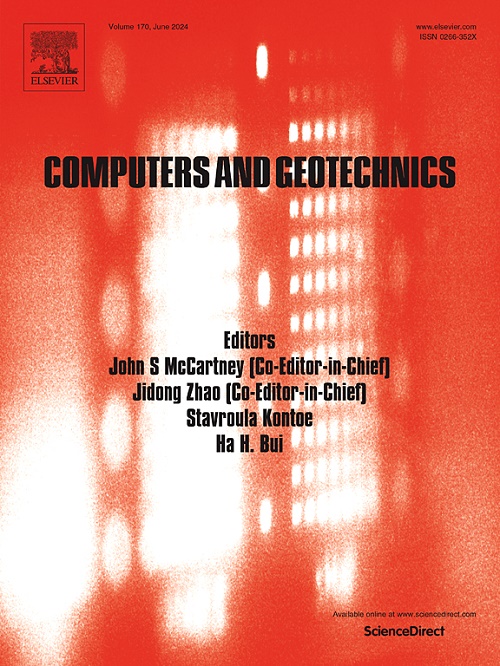Dynamic response of slopes under near-field seismic excitation using the material point method
IF 5.3
1区 工程技术
Q1 COMPUTER SCIENCE, INTERDISCIPLINARY APPLICATIONS
引用次数: 0
Abstract
Seismic-induced landslides exhibit distinct instability mechanisms compared to gravitational landslides, characterized by dynamic features such as tension, projection, and directionality. This study investigates the dynamic response and instability mechanisms of near-fault slopes under seismic excitation using a simplified bedrock-slide body dual-structure slope, with failure process simulations conducted through the Material Point Method (MPM). The results indicate that periodic seismic vibrations lead to alternating deep shear and shallow tensile failures, facilitating the formation of a continuous sliding surface. Analyzing the instantaneous unbalanced force direction of particles under seismic load reveals a correlation between slope instability and seismic wave directionality. Seismic P-waves primarily cause tensile plastic failure in the geotechnical body, with smaller slope deformation but a greater potential for ejection toward the free surface. Conversely, S-waves cause considerable deformation, driving shear plastic failure within the slope and the formation of the sliding surface. The tensile and shear plastic responses lag behind the seismic vibrations. This paper discusses the correspondence between the slope’s dynamic response under seismic action and the progressive formation process of the sliding surface, where the interaction between the seismic driving force and inertial force results in a significant accumulation of plastic strain, directly affecting the mode of sliding surface formation. Studying the inherent driving mechanisms of slope dynamic failure reveals the dynamic response characteristics of the slope under seismic excitation from multiple perspectives, offering significant implications for explaining the typical directional failure patterns of earthquake-induced landslides.
求助全文
约1分钟内获得全文
求助全文
来源期刊

Computers and Geotechnics
地学-地球科学综合
CiteScore
9.10
自引率
15.10%
发文量
438
审稿时长
45 days
期刊介绍:
The use of computers is firmly established in geotechnical engineering and continues to grow rapidly in both engineering practice and academe. The development of advanced numerical techniques and constitutive modeling, in conjunction with rapid developments in computer hardware, enables problems to be tackled that were unthinkable even a few years ago. Computers and Geotechnics provides an up-to-date reference for engineers and researchers engaged in computer aided analysis and research in geotechnical engineering. The journal is intended for an expeditious dissemination of advanced computer applications across a broad range of geotechnical topics. Contributions on advances in numerical algorithms, computer implementation of new constitutive models and probabilistic methods are especially encouraged.
 求助内容:
求助内容: 应助结果提醒方式:
应助结果提醒方式:


